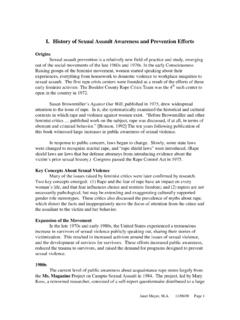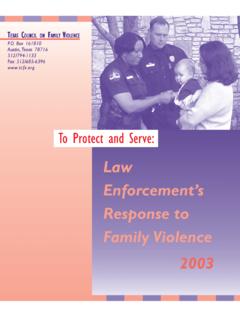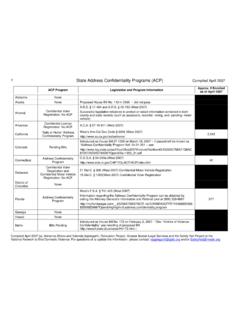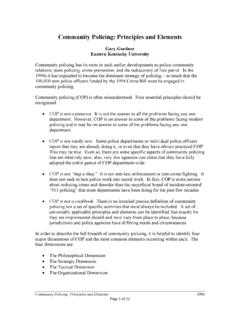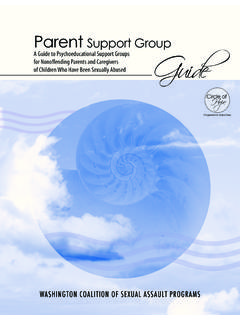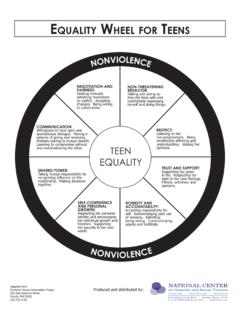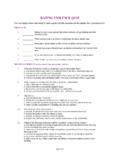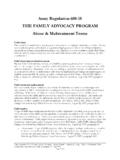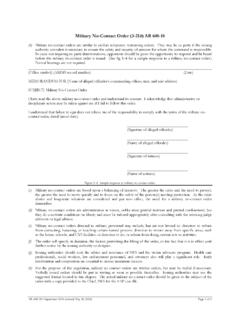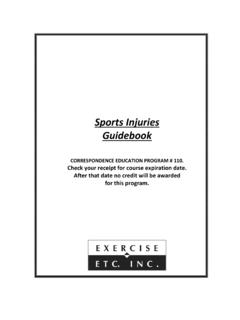Transcription of DOMESTIC VIOLENCE AND TRAUMATIC BRAIN INJURY
1 DOMESTIC VIOLENCE AND. TRAUMATIC BRAIN INJURY : Understanding the Intersections Judith I. Avner, Esq. Sarah L. DeWard, 1. Overview The Intersection of TRAUMATIC BRAIN INJURY and DOMESTIC VIOLENCE Introduction to TRAUMATIC BRAIN INJURY Effects of TRAUMATIC BRAIN INJURY on DOMESTIC VIOLENCE Survivors Strategies for Advocates Resources to Know The Importance Between 52 million and 58 million Americans (roughly 1 in 5) has at least one disability. There may be least 6 million people each year who have a permanent or temporary disability as a result of a crime-related incident. (Tyiska, 1998). 92% of women with disabilities ranked VIOLENCE and abuse as the top priority of topics that affected their lives. (Berkeley Planning Associates, 1996). The Importance Women with disabilities experience the highest rate of personal VIOLENCE VIOLENCE at the hands of spouses, partners, boyfriends, family members, caregivers, and strangers of any group in our society today.
2 Yet, they are often invisible in the crime statistics, frequently find community services such as DOMESTIC and sexual VIOLENCE programs inadequately prepared to fully understand and meet their needs, face disability service systems that don't clearly see and effectively respond to the VIOLENCE , and are all too commonly devalued and unsupported because of societal prejudice.. University of Minnesota, Impact Magazine, Fall 2000: The Importance Every 23 seconds a person in the United States sustains a TRAUMATIC BRAIN INJURY (TBI). 5. Comparative Incidence BRAIN INJURY Association of America, 2005. Leading Causes of TRAUMATIC BRAIN INJURY CDC 2007. LIFE WITH BRAIN INJURY . BRAIN INJURY is the silent epidemic million people in the US are living with a long term disability due to BRAIN INJURY 8. Epidemiology of TBI in Civilians An estimated 10 million Americans are affected by stroke and TBI, making BRAIN INJURY the second most prevalent INJURY and disability in the United States Every 23 seconds, one person in the United States sustains a TRAUMATIC BRAIN INJURY .
3 Million Americans survive TRAUMATIC BRAIN injuries each year. More than 55,000 people die every year as a result of TRAUMATIC BRAIN INJURY . 56% of adults with BRAIN injuries tested positive for blood alcohol. Each year, 2-4 million women are physically abused by an intimate partner. The head, face and neck are the most frequent sites of INJURY . The Signature Wound . The Tip of the Iceberg As many as 20% of US combat troops leaving Iraq and Afghanistan are affected by TRAUMATIC BRAIN it is unknown how many soldiers have suffered a TBI. during OEF/OIF. The incidence of moderate to severe TBI's are well captured, but the overall incidence of mild TBI or concussion in the military is The effects of concussion from blast INJURY are not always immediately apparent. 1 Army Task Force Report, May 2008. Blasts Are the leading cause of TBI for active duty military personnel1. Account for 69% of TBI cases in the current conflicts2. 1 The Defense and Veterans BRAIN INJURY Center, http:// 2 CRS Report for Congress, US Military Casualty Statistics, OIF and OEF, August 17, 2007.
4 DOMESTIC VIOLENCE and TBI. Greater than 90% of all injuries secondary to DOMESTIC VIOLENCE occur to the head, neck or face region. (Monahan & O'Leary 1999). 12. Women Reporting to ERs for Injuries Associated with DV: 30% of battered women reported a loss of consciousness at least once. 67% reported residual problems that were potentially head- INJURY related. 13. (Corrigan 2003). Some Types of Physical Abuse Hitting Throwing Twisting Pinching Shoving Elbowing Bending Shoving out car Slapping Burning Grabbing door Pushing Branding Squeezing Putting pillow Hair pulling Knocking down Biting case over head Strangling Head butting Tripping Smothering Kicking Hits to the head Stabbing Denying access to medication, Kneeing Hits to the ears Cutting medical attention, Holding Slamming Knifing food, phone Dragging Shaking Shooting THE BRAIN . Controls everything we do breathing walking talking thinking behaving feeling 15. DEFINITION: ACQUIRED BRAIN INJURY . INJURY to the BRAIN which is not hereditary, congenital or degenerative, and may include BRAIN damage resulting from events such as stroke, aneurysms, anoxia from near drowning, toxic substances or TRAUMATIC BRAIN INJURY (TBI).
5 16. ACQUIRED BRAIN INJURY . INCLUDES: Aneurysm Stroke Encephalitis Anoxia TRAUMATIC BRAIN INJURY - Gunshot wound - Concussion blast injuries - Head hitting windshield - Severe whiplash - Shaken Baby Syndrome - DOMESTIC VIOLENCE Toxic exposure (CO, lead paint, neurotoxins, inhaled vapors). ACQUIRED BRAIN INJURY . EXCLUDES: Congenital Disorders Intellectual Disabilities Cerebral Palsy Birth Injuries Progressive Disorders Alzheimer's Disease Psychiatric Disorders In which there is no known or obvious central nervous system damage 18. DEFINITION: TRAUMATIC BRAIN INJURY . TRAUMATIC BRAIN INJURY is a specific type of damage to the BRAIN that results when the head: hits a stationary object ( , windshield in a car crash). is hit ( , mugging). is penetrated ( , gunshot wound). is violently shaken by external force( , Shaken Baby Syndrome, severe whiplash). Concussion blast INJURY Often included, especially in terms of service provision groups, are individuals with other types of post-natal acquired injuries, such as strokes or aneurysms.
6 19. HOW BRAIN DAMAGE OCCURS. The BRAIN is a complicated organ, with millions of cells and connections. While specific areas of the BRAIN may be related to specific functions, in reality each function (walking, lifting an arm, speaking, etc.) involves many areas of the BRAIN communicating and interacting with each other. HOW BRAIN DAMAGE OCCURS. Damage to the BRAIN may vary in extent, area and type of damage depending upon: nature of the INJURY severity of the INJURY how the INJURY occurred quickness of medical response HOW BRAIN DAMAGE. OCCURS IN A TBI. Focal Damage Skull Fracture Contusion or bruises under the location of a particular area of impact Fronto-Temporal Contusions/Lacerations Bruising of BRAIN or tearing of blood vessels in the frontal and temporal lobes of the BRAIN caused by BRAIN hitting or rotating across ridges inside skull Diffuse Axonal INJURY Shifting and rotation of BRAIN inside skull will result in tearing and shearing injuries to the BRAIN 's long connecting nerve fibers or axons 22.
7 HOW BRAIN DAMAGE. OCCURS IN A TBI. Some time after the INJURY the following may affect the BRAIN : Hematoma (Blood Vessel Damage). BRAIN Swelling Increased Intracranial Pressure Intracranial Infection Seizures 23. CUMULATIVE EFFECTS OF. REPEATED CONCUSSIONS. History of 3 previous concussions increases risk of repeated concussions 3- fold. Athletes with history of 3+ concussions report significantly more symptoms and have lower memory scores at baseline Symptoms following repeat concussions may be more serious and resolve at a slower rate Worse case = second-impact syndrome 24. REPEATED BRAIN INJURY . Typical of ongoing DOMESTIC VIOLENCE . Leads to increased cognitive, physical, and emotional dysfunction over time. (Hibbard 2002). 25. EVERY PERSON WITH. BRAIN INJURY IS DIFFERENT. There are vast differences from person to person because: Every individual is different prior to an INJURY Every BRAIN INJURY is different 26. COMMON PROBLEMS. AFTER BRAIN INJURY .
8 Broad Functional Categories: PHYSICAL. COGNITIVE. EXECUTIVE FUNCTIONING. AFFECTIVE/BEHAVIORAL. PSYCHOSOCIAL. 27. COMMON PHYSICAL PROBLEMS. AFTER BRAIN INJURY . Loss of Smell and Taste Hearing Loss Visual Difficulties Balance Difficulties Dysarthria Motor Control and Coordination Fatigue Seizures Decreased Tolerance for Drugs and Alcohol Headaches Sleep Disturbances 28. COMMON COGNITIVE PROBLEMS. AFTER BRAIN INJURY . Short Term/Working Memory Attention Concentration Distractibility Decreased Verbal Fluency/Comprehension Information processing Arousal Problem Solving Charged Intellectual Functioning Abstraction and Conceptualization Slowed Reaction Time 29. COMMON EXECUTIVE. FUNCTIONING PROBLEMS AFTER. BRAIN INJURY . Goal Setting Self-Monitoring Planning Initiating Modifying Bringing to Completion 30. COMMON AFFECTIVE/BEHAVIORAL. PROBLEMS AFTER BRAIN INJURY . Impulsivity Emotional Lability Irritability Decreased Frustration Tolerance Impaired Judgment Tension/Anxiety Depression Aggressive Behaviors Disinhibition Changed Sexual Drive Changed Personality 31.
9 COMMON PSYCHOSOCIAL. PROBLEMS AFTER BRAIN INJURY . Educational/Vocational Problems Interpersonal Difficulties - Intimacy/Sexuality - Dependency Issues - Alcohol/Drugs Intra-Personal Difficulties - Loss of Self Esteem - Depression/Frustration/PTSD*. - Shaken Sense of Self - Profound Sense of Loss Family Issues 32. RESULTS OF BRAIN INJURY . These are just lists of resulting problems that may occur. Not all individuals with a BRAIN INJURY will have all these problems and each person may have a different combination of problems or deficits . 33. HOPE FEAR ANXIETY. CONFUSION. the INJURY . GUILT BEWILDERED. SHOCK. ISOLATION. ANGER. PAIN. DENIAL. 34. A SAMPLING OF TREATMENT PROVIDERS. Psychiatrist Neurologist Social Worker Orthopedic DOMESTIC Surgeon VIOLENCE Advocate Physiatrist job coach Speech Waiver Providers Therapist Community -based Pharmacist Pain Mgmt Providers Specialist Behavioral Neuropsychologist Optometrist Support Clergy Psychologist Massage Therapist Groups Physical Therapist Chiropracto Urologist Substance Occupational Nurses Abuse r Therapist Counselor 35.
10 RESULTS OF BRAIN INJURY . Remember, since you are talking about a BRAIN that started out intact and then was damaged, people with BRAIN INJURY will have many intact abilities. This is you or me with some areas of function changed. 36. WORKING WITH SURVIVORS. WITH BRAIN INJURY . It is critical to understand the individuals with whom you work so that you know what they are capable of doing for themselves and what they need help with ( , the type and level of support). Don't be mislead by what looks like a personality trait or a willful decision. You may be seeing BRAIN INJURY related behavior. 37. DOMESTIC VIOLENCE And Women With Disabilities: A Power &. Control Perspective Survivors Disabled as a Result of DOMESTIC VIOLENCE Can result in permanent or temporary disability (TBI). Constant, inescapable reminder of abuse New health challenges; exacerbation of existing health issues Dramatic changes in family dynamics (lose custody, abuser becomes primary caregiver).
